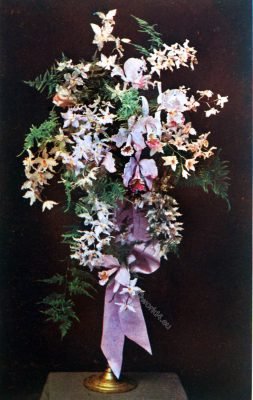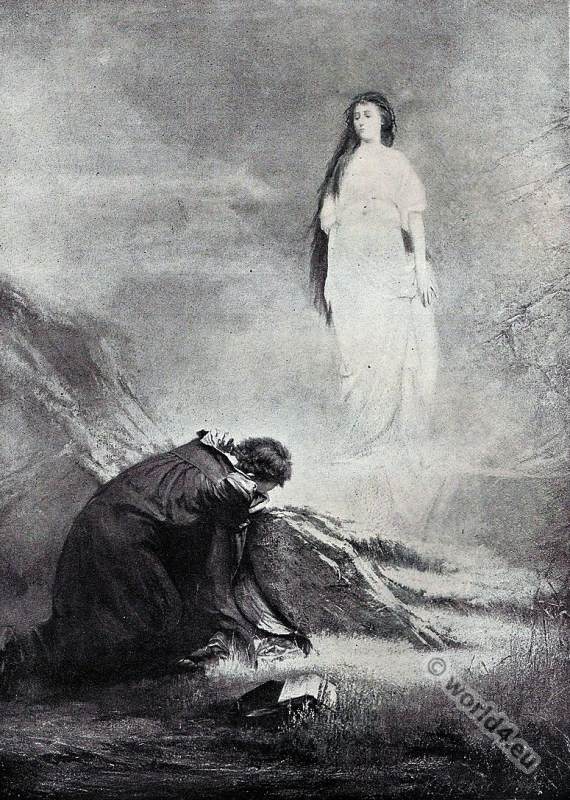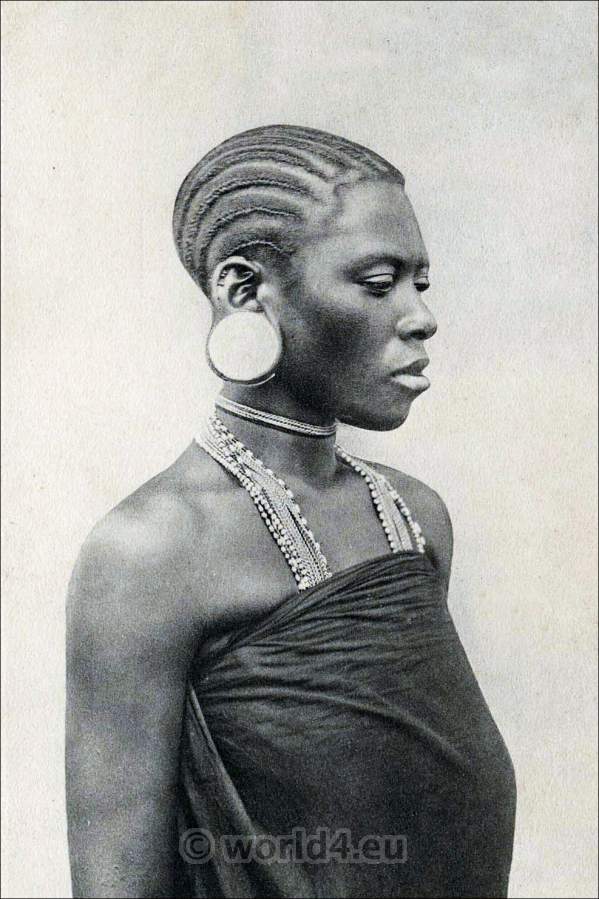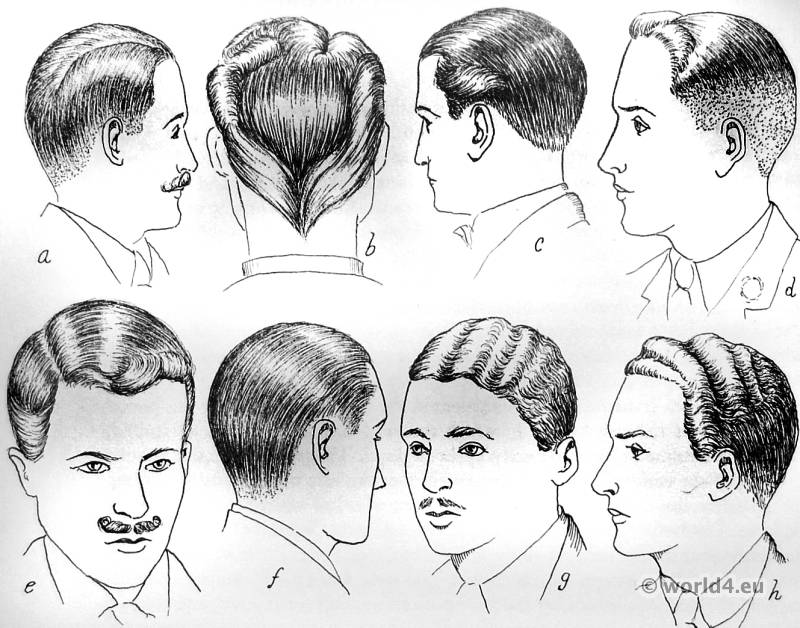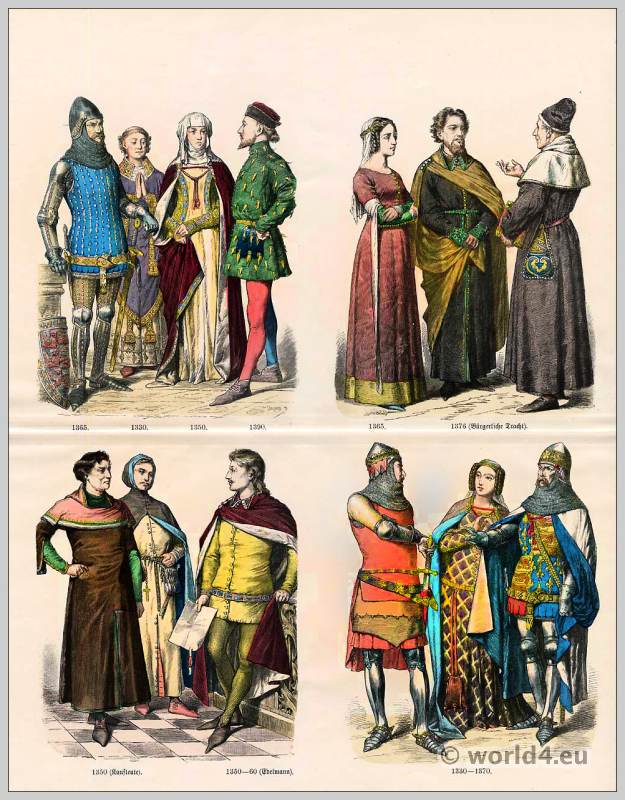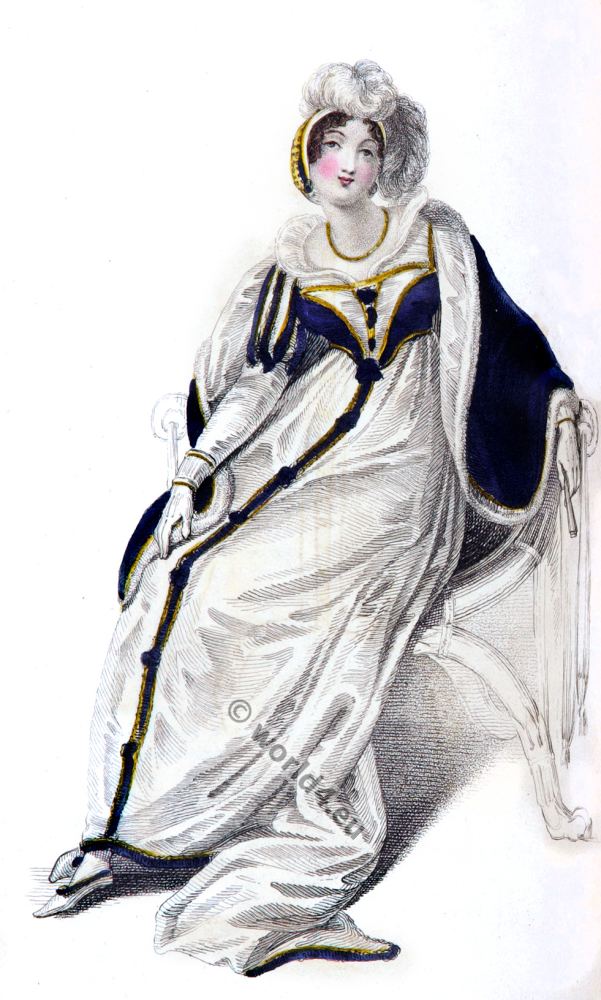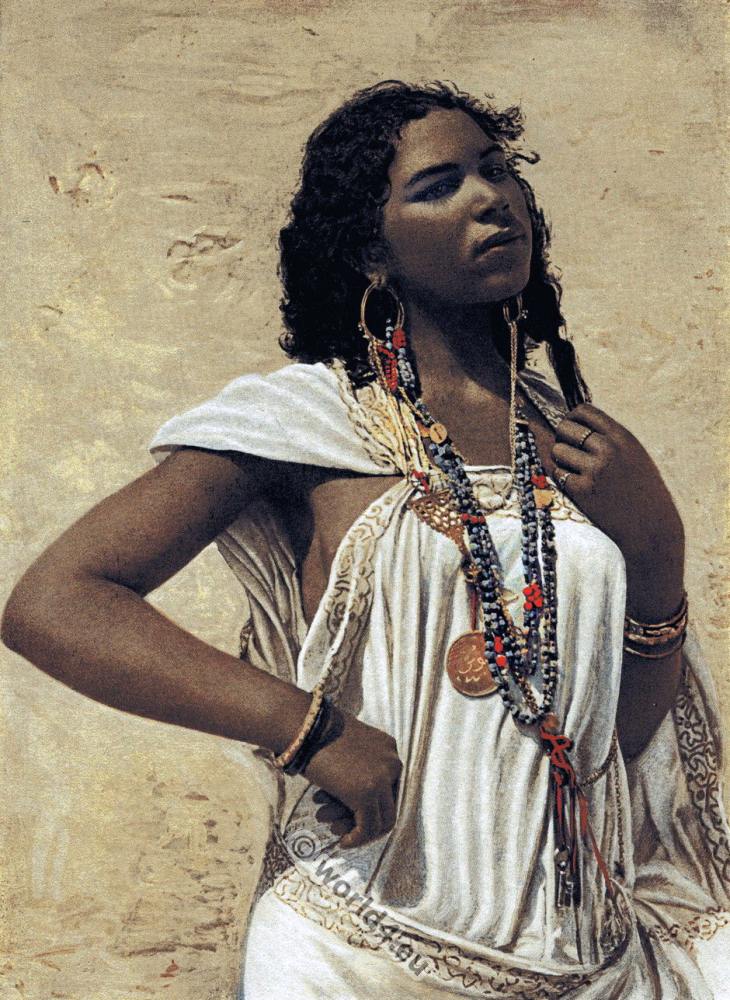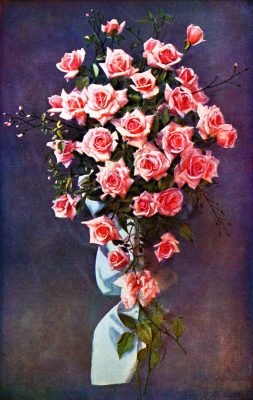
BRITISH FLORAL DECORATION.
English roses: history and varieties
“De mémoires de Roses on n’a point vu mourir le Jardinier.” (“The Gardener has never died in the memory of Roses”)
A Rose in the garden slipped her bud
And smiled in the pride of her youthful blood
As she saw the gardener passing by-
“He’s old, so old, he soon will die,”
Said the Rose.
And when morning came with sunshine bright
She opened her warm red heart to the light,
And sighed as the gardener passed the bed-
“Why he’s older still, he’ll soon be dead.”
But evening closed with a cold night air
And the petals fell from that rose so fair,
And when morning dawned came the gardener old
And raked them softly under the mould.
And I wove the thing to a random rhyme-
For the Rose is Beauty, the gardener Time.
Poems of Sentiment: I. Time
A Fancy from Fontenelle
Austin Dobson (1840–1921)

ARDENT patriots have been known to cavil at Richard Coeur de Lion for his adoption of St. George as the patron saint of England. There are many British saints, they say, who might with equal propriety have been chosen to preside over the fortunes of a warrior nation. It is otherwise with the floral emblem of our land, “the red, all-conquering Rose,” which we owe to Edward I.
As becomes a monarch who habitually spoke English (the first of his race to do so), Edward took for his badge a flower indigenous to British soil, and symbolic in many ways of England and all that England stands for.
No floral emblem has played a greater part in the life of any nation. The Lily ranks next in this respect, but this flower has long since disappeared from the blazon of France, and at its best stood for the monarchy far more than for the people.
Some English Kings wavered for a time in their fealty to the Rose. Henry IV. favored the Forget-me-not, and Henry VII. introduced a Hawthorn into’ his device in remembrance of the bush where the battered crown of Richard III. was found after Bosworth Field. Public opinion was opposed to the change, however, and Henry found it advisable to reinstate the Rose in the royal badge of England, where it has always since figured.
Edward IV., who, according to Stowe, was” the beautifulest prince of his time,” received from his loyal subjects the name of the Rose of Rouen, he having been born in that town. Edward was a devotee of the rose, and the first monarch to issue a coin adorned with the national flower. This was the gold rose-noble, inscribed with the appropriate motto, “Rosa sine spina” – A rose without a thorn. His example was followed by several of his successors, and the rose-noble of Henry VIII. is held by many to be the most beautiful of all English coins.
Although the Rose has since the time of Edward I. been accepted as the national flower of England, there has been in our time a determined attempt to oust it from its place. So recently as on the occasion of the coronation of His Majesty King Edward VII. a most strenuous effort was made by certain people to substitute on that day the Lily for the Rose, and it was openly stated in many of our daily papers that the Lily was to be the flower worn on Coronation Day. Those who were responsible for this crusade against the Rose alleged that the Lily of the Valley was Her Majesty Queen Alexandra’s favorite flower, which, by the, way, was not true.
Luckily a few people of very high rank took the matter up, and a Society was hastily formed calling itself “The Rose for England Society.” I was invited by them to contribute an article for publication, and I think it would not be out of place here to quote the letter to the Press and Miss How’s poem, as they, in conjunction with many other vigorous Press articles, helped to defeat the ends of those who wished to displace the Rose.
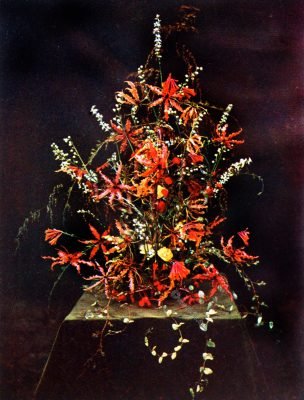
A PLEA FOR THE ROSE
“Sweet Rose of Denmark, England’s worshipped Queen,
The fairest Rose that ever monarch wore,
I bring to thee a humble sister’s plea,
The plea of one who weeps-a Queen no more.
“The Rose, the Shamrock, and the Thistle, we
Were Britain’s emblem, in a glorious past;
And I, the Rose of England, reigned a Queen-
Badge of my country-Royal to the last.
“Must I, then, hang a sad, dishonored head,
And red with shame, or white with bitter grief,
Bloom in each English garden all in vain,
While my pale rival, folded in her leaf,
“Shall shake her little silver bells in scorn,
Seeming to mock me as I droop discrowned;
When the June sunshine gilds an Empire’s throne,
And all the land is full of joyful sound?
“Ah! bid me sparkle forth in diamond dew
To share the triumph of that glorious hour,
Strewing the pathway of my King and Queen,
The English Rose-the Coronation Flower.”
M. How.
DEAR SIR,- I have seen in many papers, and among them some of the leading “dailies,” that a vigorous attempt is being made to establish the Lily of the Valley as the Coronation flower, and I cannot refrain from taking up my pen to defend the claims of the Queen of flowers, our grand National Rose.
The bare idea of having to defend it seems to me so preposterous that I feel I ought to apologise to every good English subject for seriously listening to such an idea as the substitution of any flower for the Rose at the coronation of a King of England. Unfortunately, however, the Lily movement appears to be daily gaining ground, not so much, I believe, with the people as with the great producers, to whom I cannot help thinking the matter owes its origin.
Passing over entirely the historical associations of the Rose with the English Crown, hallowed by centuries, and ignoring the fact that the Lily was once the royal flower of France, I will confine myself purely to common-sense reasons why the Lily should not be adopted.
First of all, it is by no means as English a flower, in its natural state, as the Rose. Secondly, more than nine-tenths of the Lilies of everyday commerce are primarily produced abroad, and are only finished, either by forcing or retarding, in England. Thirdly, the comparatively few naturally grown English Lilies of the Valley will be over by the end of June, unless the season should happen to be a backward one, and so we should have to fall back on the foreign growers for our supply, and in that case only those living in towns would be able to get them at all.
On the other hand, Rose-growing being an immense industry in the United Kingdom, the supply in June will be almost inexhaustible; therefore every man, woman, and child will be able to wear them, even though they have to go out and pluck wild ones from the hedgerow.
Yours, &c.,
R. F. FELTON.
The Wars of the Roses no doubt stimulated the national regard for the Rose, but quite aside from their use as partisan emblems, many passages in contemporary writers go to show that in the Middle Ages Roses were the most popular flowers in England. In those days Rose-lovers had to content themselves with the six native species, for no aliens had yet reached our shores.
The fifteenth century, however, witnessed the arrival of the Damask Rose and the Provence Rose, which soon became universal favourites, and by Shakespeare’s time there were over twenty varieties that could be distinguished one from another.
Thus about this time we begin to find Roses not only in the garden, but in the storeroom, the stillroom, and even strewn on the floor in lieu of carpets.
Old cookery books abound in recipes for preserving, compounding, and distilling Roses. Here we read of “Conserve of Red Roses in the Italian Manner,” “Marise of Roses,” and the unpleasantly named Cynorrhodon (rose hip), composed of pulped Dog Roses. Cooks went so far as to prepare a dish consisting of “the brains of birds and pigs well boiled with some fragrant Roses pounded in a mortar “-a most unhallowed mixture. In case of illness recourse was had to such cordials and medicines as “tincture of Roses” and “Sweetbrier Rose vinegar.”
Every well-equipped household possessed a Rosestill, and made Rose-water in lavish abundance. This was used not only for toilet purposes, but also to flavour all kinds of food, even meat and fish. Rose-water also formed the basis of a drink beloved of old-time roysterers, known as Rosa Solis. The other components were aqua vitee, orange-flower water, and extract of cinnamon, the whole forming an insidious and potent mixture, warranted, Dekker tells us, “to wash the molligrubs out of a moody brain.” We hear of this drink from Pepys, when one of his boon companions, filled with Rosa Solis, leaps from a high balcony- “the greatest and desperatest frolic I did ever see.”
The amount of Roses consumed in these various forms must have been very great, but still there were enough left to strew the floors in the houses of the wealthy. In old-time domestic accounts which have been preserved we find the item “strewing Roses and herbs” constantly recurring. When there was a glut of Rose-leaves in the market they could be purchased for sevenpence or eightpence a bushel, but as a rule they realized considerably more than this.
For people who could not afford the luxury of Rose-strewn floors there was a perfume sold “to burn on coals to make the house as though full of Roses.” So we can picture the England of those days as abounding in Roses.
Under the Commonwealth, however, their popularity received a temporary check. The craze for Tulips spread from Holland, and was stimulated by the Puritan prejudice against a flower which figured largely in the revels of pagan Rome. That patriotic divine, Thomas Fuller, issued a protest on behalf of the national emblem. “There is a flower,” he wrote, “a Toolip, which hath engrafted the love and affection of most people into it. And what is the Toolip! A well-complexioned stink, an ill flavour wrapped up in pleasant colours. Yet this is that which filleth all gardens, hundreds of pounds being given for the root thereof, whilst I, the Rose, am neglected and contemned, and conceived beneath the honour of noble hands.”
The fashion, apparently, did not last long; for Sorbières *), who visited England soon after the Restoration, dwells enthusiastically on the Rose-bedecked gardens which he found everywhere in Kent.
*) Samuel de Sorbiére (1615–1670) was a French scholar, physician, translator and doctor.
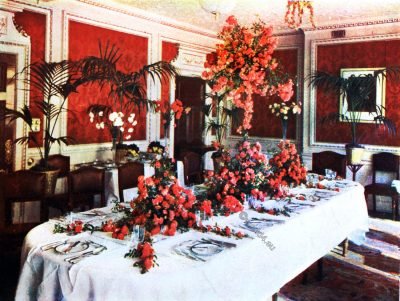
In the eighteenth century popular appreciation of Roses began to show itself in a less prosaic form. They no longer figured as an ingredient of cookery, and Rosa Solis went out of fashion among drinking men; but the potpourri jar made its appearance, and was soon to be found in every self-respecting household.
Other flowers of the garden perish,
Sweet Roses do not so:
Of their sweet death are sweetest odours made.
A delicate fragrance ‘of Roses seems to have haunted all the primly furnished parlours of the days of the Georges.
As England extended her dominions the fitness of the Rose as a national emblem became more and more apparent. Like the British Hag, it is at home in all parts of the globe.
From Central Asia, its place of origin, it has expanded its paradise of flowers as far as Abyssinia in one hemisphere and Mexico in the other. The coldest climate holds no terrors for a flower which has conquered Greenland and Kamchatka. – Species of Roses are found even in parts of Iceland, where vegetation is so scanty that the natives are often driven to feed their cattle on dried fish, and they bloom on the polar shores of Hudson Bay and in the snow laden districts of Lapland – during their all too short summer.

Few indeed are the British colonies where theRose does not flourish. It is, however, not indigenous to Australasia; but, thanks to extensive importation from the Mother Country, Roses now grow in profusion both in Australia and in New Zealand. Loyal colonists, amid all the luxuriance of their Southern vegetation, find a large corner for the flower which recalls the land they hold so dear.
It is fitting that the greatest of modern Empires should be represented by a flower which has taken all the world for its province, and is itself the monarch of flowers. The Rose’s claim to this position has been asserted by a line of poets ranging from Sappho to Mrs. Browning.
What’s the best thing in the world?
June Rose, by May-dew impearled.
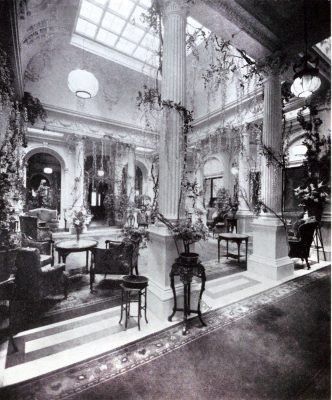
Neither has the Rose been forgotten in the world of song; hence we find, among many more or less popular airs taking Roses for their theme, “The Last Rose of Summer,” and “She wore a Wreath of Roses,” two songs which will live for ever.
And its very name proves it to be the flower of flowers par excellence. This name varies but slightly in any language, and Max Muller has shown that its root is to be found in an Aryan word signifying a flowering shrub, thus marking it as the flower of the vegetable world, taking rank above all others. That its name is a symbol of beauty is also shown by the fact that it has been conferred on many plants which have no claim to it.
Thus we find the Christmas Rose, the Guelder Rose, the Alpine Rose, the Water Rose, the Holly Rose, the Tuberose, and the Primrose, all masquerading under false pretenses in the world of flowers.
If any further mark of its popularity were needed it can be found in the fact that it has been adopted as a standard colour by all nations and in all businesses throughout the world. Hence in porcelain we find “Rose du Barry” and “Rose Pompadour“; in silks “vieux rose” and every imaginable shade of rose is employed in the colour-charts of silkweavers. And it has also been for centuries one of the favourite names for the daughters of England and all other nations.
France and England have been rivals in Rose culture as in many other fields, and in the days when Josephine formed her peerless garden at Château de Malmaison this country was to some extent left behind in the race. Since then, however, we have more than regained the lost ground.
During the last twenty years so rapid have been the strides made by English raisers and growers that it may be safely said that we are now well ahead of any other nation in the world, both in the production of new varieties and the perfection of their culture.
I have seen many of the great Rose shows in France, but although their methods of showing them are somewhat more ornate and fanciful than our own, I can say without fear of contradiction that no other country could possibly get together such magnificent collections of flowers as are to be seen annually at the Summer and Autumn Shows of the National Rose Society of England.
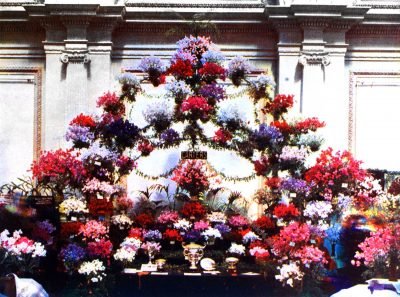
Seeing the great number of flowers that are annually imported from the South of France to England, it is comforting to be able to record that
England now annually exports special varieties of Roses in huge quantities to Paris, and even Berlin and Hamburg and other important continental towns. One English firm alone exported last year to France and Belgium many hundreds of Wichurianas (The Memorial rose, a wild Asian type of rose) in pots, and I sent numbers of them in full bud to Germany.
We hear from America of the wonders of the American Beauty and American Roses generally, but some years ago I had the pleasure of escorting the leading Rose-grower of America to one of the great English nurseries at Uxbridge, where Roses are grown for cutting only, and he was bound to admit that he had never seen anything half as fine on his side of the Atlantic.
If any English grower could be sure of getting the prices that prevail in America for specimen Rose blooms, I am confident Messrs. Low, of Uxbridge, Messrs. Rochford, of Rochfordville in Hertfordshire, and others, would have no difficulty in producing them, but how many English people are there who would pay a dollar each for cut Roses in quantity? My experience tells me they are very few and far between. Yet this is the price at which hundreds are sold daily in New York. As I write I have before me a list of prices from the leading American horticultural trade paper quoting American Beauty “specials” at nine dollars per dozen wholesale.
The French have left their impress on the nomenclature of the plant; hence Provence, Noisette, Damask, and Bourbon are descriptive names of important sections, and Maréchal Niel and Gloire de Dijon are familiar in our mouths as household words. To most of us, however, names such as York and Lancaster, Musk, Sweetbrier, or even Dog Rose seem better suited to a flower which, although in one sense a citizen of the world, recalls England wherever it is met.
BEST VARIETIES FOR DECORATIVE WORK.
The stern necessity of cutting down the number of varieties in the various sections of Roses will be apparent to everyone when they are reminded that, so long ago as 1830, there were 2300 species and varieties in existence, and even to-day we find many growers’ catalogues containing somewhere over a thousand names. If one reads the descriptions in these lists one finds little help in making a selection, as they are practically all described as possessing some special charm.
It has indeed been a difficult task for me to reduce their numbers to reasonable and practical proportions. I have, however, kept steadfastly in my mind during the course of my work the main object of this book, and, although I have had to pass over many old favourites and magnificent Roses, I feel safe in promising my readers that if they adopt the varieties which are named, they will not go far wrong from a decorative and artistic point of view. I feel that I owe an apology to hundreds that I have perforce had to leave out, but those Rose-lovers who miss some of their special fancies must take it for granted that, as far as lay in my power, and helped by copious and kindly advice from many recognized experts, nothing has been left out without careful thought and unprejudiced consideration.
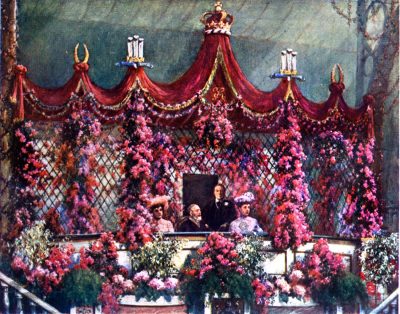
HYBRID TEA ROSES.
There is no doubt that this section is by far the most valuable to those interested in decorative work, and I therefore reverse the usual order of things, and place them first in the list.
p* Mme. Abel Chatenay. A true salmon colour, without a suspicion of blue. I feel justified in saying that I have had something to do with the great popularity of this superb rose, as for some years I kept practically the whole supply of best quality cut flowers entirely in my own hands, and as this created a demand from other sources more and more were grown until every florist can now. be supplied. It is far the best market rose in cultivation.
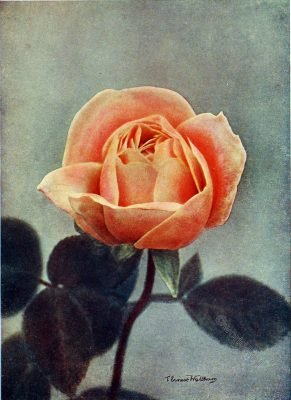
- * Betty. A coppery peach colour with golden enrichment. In my opinion one of the most beautiful roses in the world.
p* Lyon Rose. I predict a great future for this lovely rose. Its colour changes with every stage of its development. As a bud it is a deep bronze, and as it opens the colours baffle description.
p* Liberty and * Richmond. The two best red roses for pot-culture, as with good management they will crop for nine months in the year.
p* La France. When at its best this is still, in my· opinion, the best H. T. - * Mme. Ravary. Pale orange yellow. A great favourite for table decoration.
p* Kaiserin Augusta Victoria. A fine rose both in and out of doors. Creamy white. - * Mme. Mélanie Soupert. A great florist’s rose, and a most fascinating colour.
- * Edu Meyer. Rosy red shaded copper.
p* Caroline Testout. Although not a good shape, this flower, owing to its grand habit, is well worth a place in every garden.
p* White Killarney. This has to be a fine rose to do all that is promised of it. I think it is too thin to become very popular.
p* Lady Ashtown. One of the best all-round roses in existence.
Killarney. This rose I am bound to include although it is not a favourite of mine. Much better on the plant than cut. - *Countess of Gosford. A sweetly pretty shade of salmon pink.
- *Marquis de Sinety. Golden red with a gentle shading of warm bronze.
- *Dorothy Page-Roberts. This is a most chaste and beautiful colour.
Viscont Folkestone. A blushing white, sometimes much deeper than others.
William Shean. An enormous true bright pink rose of splendid quality.
Gustave Regis. Glorious shade of yellow. A perfect bud for buttonhole work.
Earl of Warwick. Rosy salmon.
Pharisaer. This rose is almost always in flower.
Paul Lede. Not a very good grower, but a splendid rose.
Florence Pemberton. A fine all-round rose.
Joseph Hill. One of the very best when well done. Salmon-pink shaded golden bronze, lovely.
Ecarlate. A brilliant colour for the garden.
Mme. Segond Webber. Salmon faintly shaded rose, but oftentimes developing a lovely deep rose centre.
Countess of Derby. A good garden rose, very free when it gets going.
All the varieties enumerated above are so beautiful that it is difficult to individualize, but those marked * will be the most useful for all-round purposes. Those marked p are suitable for growing in pots.
A FEW NEWER HYBRID TEA ROSES which have struck me favorably, and which all large fanciers will be safe in purchasing at once.
Mrs. David Jardine. A gem of the first water.
Margaret Molyneux.
Lady Pirrie. A wonderful colour.
His Majesty.
George C. Waud. Unique in colouring and one of the finest of the new ones.
Duchess of Wellington. A marvellous bit of colour.
Mrs. Arthur Munt.
Lady Alice Stanley. A most striking rose, full of quality.
Lady Ursula.
Jonkheer von Mock. New and charming colour.
HYBRID PERPETUALS
Aimee Vibert.
Alfred Colomb.
Commandant Felix Faure.
p* Captain Hayward.
- * Commander Jules Gravereaux.
- * Duke of Wellington.
Duke of Teck.
Earl of Dufferin.
p* Frau Karl Druschki.
p* General Jacqueminot. - * Hugh Dickson.
p* Mrs. John Laing. - * Mme. Gabriel Luizet.
p* Mrs. Sharman Crawford. - * Prince Camille de Rohan.
Susanne Marie Rodocanachi.
p* Ulrich. Brunner. - * Victor Hugo.
Zepherin Drouhin (The Thornless Rose).
* A fine representative dozen. p Are suitable for pot culture.
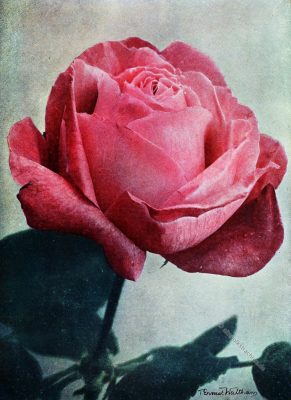
TEA ROSES
- * Anna Olivier.
- * Beryl.
p* Bridesmaid.
Comtesse de Nadaillac.
p George Nabonnomd. - * Harry Kirk.
p* Lady Roberts. - * Lena.
p* Mme. Hoste.
Meta.
Paula.
Mme. Chédane Guinoieseau.
p* Sunrise.
Mme. Constant Soupert. Souvenir of Stella Gray.
Molly Sharman-Crawford.
p* The Bride. - * Mme. Jules Gravereaux.
Lady Hillingdon. This new rose must be grown by all rose-lovers. It is a perfect glowing orange colour, and a very shapely bud.
Mrs. E. Mawley.
p* Maréchal Niel. Under glass this is the finest tea rose that has ever been raised. It seems, however, to be going out of fashion as a cut flower, but this is entirely due to the rage for long, strong stemmed varieties.
* A representative collection. p Are suitable for pot culture.

SINGLE ROSES AND BRIERS
- * Irish Elegance. One of the most beautiful decorative roses ever raised.
Irish Glory and Irish Harmony. Exquisite productions.
Lady Curzon. Palest pink-very elegant. - * Mrs. O. G. Orpen. A gem of the first water. If it were a little less formal it would be perfect.
- * Austrian. Copper. A colour which creates a perfect glow of warmth.
Simplicity. A big single white of rare beauty. - * Una. Rosa Moschata alba. Joseph Billiard.
Flora McIvor. All Lord Penzance’s Hybrids are beautiful, but I consider this and the two named after himself and Her Ladyship are the best.
Macrantha. A blush pink; one of the finest singles. - * Juliet. This is one of the most wonderful breaks in colour.
- * Lady Penzance.
- * Lord Penzance.
- * Gottfried Keller.
* These are my particular fancy.
The suitability of the above Roses for floral work has been very forcibly illustrated at the National Rose Society’s shows, where for some years I have judged the decorative classes and can therefore vouch for the fact that ninety per cent. of the highest awards have fallen to work in which one or more of them have been employed either alone or in conjunction with other varieties.

WICHURIANA ROSES
“If anything could make me wish to have a large house instead of a small one, it would be that I might have a wider expanse of wall up which to grow clambering Roses.”
ALFRED AUSTIN.
In addition to the charming effects, in every position in the garden, which all this section gives us, they have great decorative value when grown in pots. Their advent has opened artistic possibilities which cannot be over-estimated. They are not only invaluable when grown in a perfectly natural way but are also most interesting if trained in fantastic forms. Last season we had airships, windmills, open umbrellas, elephants, and many other curious shapes, and we have a great many new and original designs already made up for coming seasons.
It is a pity that more is not done in England in the way of training such things as lend themselves to the art into classical and fancy designs, instead of perpetuating balloons, standards, pyramids, and such-like relics of our forefathers. It really only requires a little more time and patience and English growers might do worse than emulate the Japanese in this matter.
- * Lady Gay. Dorothy Perkins. Minnehaha. There is little difference in these varieties, but I consider Lady Gay the best of the three. Minnehaha is not quite so free, but the trusses of flower are longer and more pointed, and thus most useful for cutting.
- * Crimson Rambler, Philadelphia. Philadelphia is much the better of the two for pot work.
- * Hiawatha. A beautiful red variety, but not so free as Delight. (Sweet scented.)
- * Delight. This is a grand variety, and everyone should have it in the garden. (Sweet scented.)
- * White Dorothy. A welcome arrival.
- * Gardenia. This is decidedly the pick of the yellow Wichurianas.
Jersey Beauty. A soft shade of yellow. - * François Juranville. A lovely old rose colour tinged with salmon. .
- * Gertrude Rochford: After the style of Cant’s Blush, but more free. It makes a splendid pot plant.
Coquina. This is a great favourite of mine, a soft rosy pink produced in long and elegantly shaped trusses.
Darothy Dennison. A blush sport of Darothy Perkins.
Leontine Gervais. Rosy salmon with a suspicion of golden yellow.
* These would be my first choice if I had no room for them all.
ROSES-CLIMBERS
- * American Pillar.
Carmine Pillar. - * Cant’s Blush.
Crimson Rambler.
Flower of Fairfield.
Fortune’s Yellow. - * Gruss an Teplitz.
- * Longworth Rambler.
Mme. Pierre Cochet. - * Tausendschön: In every way this is a truly magnificent rose.
Trier.
Veilchenblau (Blue rose). - * William Allen Richardson.
Zephyrine Drouhin.
* These six are as good as any for small collections.
CHINAS, ETC.
Comtesse du Cayla. A perfect little gem. Colour almost indescribable. A glowing golden bronze about fits it.
Chin Chin. Sulphur-yellow. Is well spoken of by its raisers, Messrs. Hobbies, whose good word is always reliable.
Irene Watts. White with a touch of pink.
Laurette Messimy. Rose shading to yellow in the base.
Mme. Eugène Résal. Orange-copper, shaded soft rose.
Queen Mab. One of the most beautiful of the Chinas.
Eugène Beauharnais. A very fine and telling bit of colour.
DWARF POLYANTHA
- * Mrs. W. H. Cutbush, Baby Dorothy, Maman Levavasseur. These three are much alike in color which is bright rose pink.
- * President Taft. A large, brilliant, scented variety.
- * Mrs. Taft. A true rose-colour, compact habit, large truss.
- * Perle d’Or. Nankin yellow.
Anna Marie de Montravel and * Katharine Zeimet. Two good whites.
Jessie. A brilliant bit of rosy crimson. - * Eugénie Lamesch. Soft yellow, shaded carmine; very beautiful and deliciously sweet.
*Six quite distinct varieties of great merit.
All these make sweetly pretty little pot roses, and in groups are most useful for edging. They are also a welcome change as bedding-plants.
MOSS ROSES
Blanche Moreas. The best white moss rose.
Crested Moss. Pinky rose.
GOOD ROSES TO GROW FOR THEIR FOLIAGE
Rubrafolia. Alberic Barbier. Rosa Sinica.
As a great number of our best Roses are not blessed with good foliage it is well to have a few quick-growing ones for cutting, as fine sprays of foliage in table and other decorations are indispensable.
There is nothing that spoils the line of a Rosetable so completely as Smilax, Asparagus, or other trailing foliages or ferns.
ROSE CONTRASTS
Irish Elegance with Comtesse de Nadaillac.
” ” Earl of Warwick.
” ” Mme. Jean Dupuy.
” ” Mme. Abel Chatenay.
” ” Edu Meyer.
” ” Una.
Mme. Abel Chatenay with Mme. Ravray.
” ” ” François Juranville.
” ” ” a few Comtesse du Cayla.
Mrs. John Laing, La France, Caroline Testhout, Mrs. Sharman Crawford, Margaret Dickson, Bridesmaid, Zephyrine Drouhin, and all grayish or bluish pinks. For table decorations these should be mixed with light sprays of Lady Gay, Dorothy Perkins, Minnehaha, or for small tables with Mrs. Cutbush, Baby Dorothy.
Gruss an Teplitz with White Dorothy, using more of the former.
All the less pronounced reds, such as Captain Hayward and Suzanne de Rodocanachi; mix well with Delight, which is one of the best of the Wichurianas for all decorative purposes.
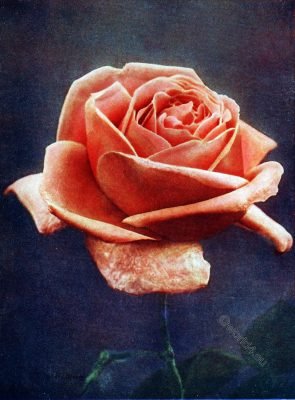
Lena with Mme. Ravray.
” ” with Gottfried Keller.
Beryl with Mme. Ravray.
” ” with Lyon Rose.
Carmine Pillar with Jersey Beauty.
Gustave Regis with Victor Hugo.
Comtesse du Cayla with Gottfried Keller.
Mrs. O. G. Orpen with Cant’s Blush Rambler.
Mme. Ravray with a few Frau Karl Druschki.
Fortune’s Yellow with Lord Penzance.
Mme. Hoste with Lady Ashtown.
Maréchal Niel with Comtesse de Nadaillac.
Hugh Dickson, Duke of Edinburgh, Commandant Fléix Faure, Richmond, Liberty. All these and any other good reds will be greatly helped by adding light sprays of Hiawatha.

ROSES WHICH MAKE LOVELY DECORATIONS BY THEMSELVES
Mme. Abel Chatenay. The foliage of this beautiful rose is unfortunately not very decorative, so sprays of Wichurianas, Rubrafolia, Sunset, or any other of those varieties producing coloured foliage should be plentifully employed, but on no account use asparagus or other greenery.
Liberty. The same instructions apply to Liberty, but in this case pale green, or, if possible, golden foliage, should be used with very few coloured shoots.
La France with a few extra sprays of its own beautiful pale green foliage.
Hugh Dickson makes a superb table, but a few small Bowers and buds must be used, as it is such a perfect rose that if all one size are used, it looks a little stiff.
Frau Karl Druschki. On a hot summer’s night there cannot be a more reposeful and refreshing table than one of fine open blooms of this gorgeous rose, with a liberal supply of long sprays of rose foliage, of varieties such as Rubrafolia or some of the Wichurianas, notably Alberic Barbier.
All the Wichurianas make beautifully light small tables, but for large ones they must be enriched by a groundwork of one of the H.P. or H.T. varieties, which matches them, or gives a strong contrast.
A table decoration, vase, or indeed any arrangement of Roses should, if possible, be made, not only of one colour, but of one variety, or the best possible results cannot be looked for.
By way of example mention might be made of two Roses which are so much alike that many can scarcely tell one from the other; they are Richmond and Liberty, yet if these two are mixed it will be found that the beautiful outline of both has been lost.
Source:
- British floral decoration by Robert Forester Felton. London: A. & C. Black, 1910.
- Roses. Hayward Radcliffe Darlington F. L. S.. New York: Frederick A. Strokes co. 1911.
Related
Discover more from World4 Costume Culture History
Subscribe to get the latest posts sent to your email.



